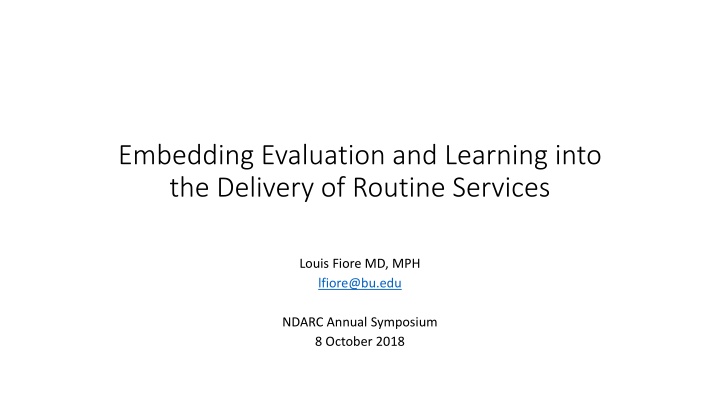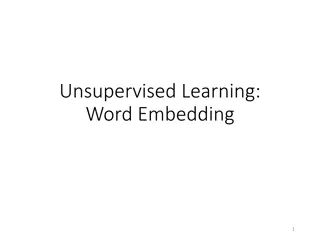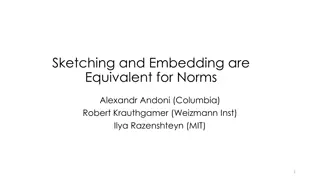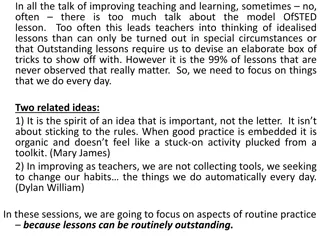Embedding Evaluation and Learning into Routine Services
Integration of evaluation and learning in routine healthcare services, emphasizing the importance of local learning, cohort identification, data analysis, and care optimization. Discover strategies for implementing learning-driven improvements in healthcare systems.
Download Presentation

Please find below an Image/Link to download the presentation.
The content on the website is provided AS IS for your information and personal use only. It may not be sold, licensed, or shared on other websites without obtaining consent from the author.If you encounter any issues during the download, it is possible that the publisher has removed the file from their server.
You are allowed to download the files provided on this website for personal or commercial use, subject to the condition that they are used lawfully. All files are the property of their respective owners.
The content on the website is provided AS IS for your information and personal use only. It may not be sold, licensed, or shared on other websites without obtaining consent from the author.
E N D
Presentation Transcript
Embedding Evaluation and Learning into the Delivery of Routine Services Louis Fiore MD, MPH lfiore@bu.edu NDARC Annual Symposium 8 October 2018
Roadmap Roadmap Learning versus discovery Requirements for learning Examples of learning healthcare system activities Lessons learned
Chapter 1: Learning versus Discovery Chapter 1: Learning versus Discovery
Traditional Observational Health Research Cohort Identification Data Cleaning Data Analysis Data Collection Research Enterprise Healthcare System Knowledge Generation Publication Translation Gap
Local Learning with Implementation Cohort Identification Data Cleaning Data Data Analysis Collection Patient Specific Decision Support Knowledge Generation Prediction Algorithm Results Individual Patient Data
Chapter 2: Requirements for Learning Chapter 2: Requirements for Learning Engagement of care providers Bottom Up Data availability and provenance Of critical data elements only Data science The easy part Ability to experiment Randomization in usual care Implementation Implement as you learn
Chapter 2: Requirements for Learning Chapter 2: Requirements for Learning Engagement of care providers Bottom Up Data availability and provenance Of critical data elements Data science The easy part Ability to experiment Randomization in usual care Implementation Implement as you learn
The VA VistA/CPRS National EHR RDW RDW RDW CDW RDW
Chapter 2: Requirements for Learning Chapter 2: Requirements for Learning Engagement of care providers Bottom Up Data availability and provenance Of critical data elements Data science The easy part Ability to experiment Randomization in usual care Implementation Implement as you learn
Chapter 2: Requirements for Learning Chapter 2: Requirements for Learning Engagement of care providers Bottom Up Data availability and provenance Of critical data elements Data science The easy part Ability to experiment Randomization in usual care Implementation Implement as you learn
Point of Care (Embedded) Clinical Trials Cohort Identification Enroll & Consent Intervention Randomize Decision Support Data Capture Analysis Study DB
Point of Care Clinical Trial Point of Care Clinical Trial A clinical trial with a substantial portion of its operations conducted by clinical staff in the course of providing patient/subject s routine clinical care and where the choice of treatment is between two equivalent options
POCR Advantages POCR Advantages Pragmatic qualities address issues of Clinical Effectiveness Faster (immediate) Integration of results into practice thereby lowering the T2 translation barrier Enhanced acceptance by providers (locally selfish) Conversion to a decision support node Improved logistics scalable
Chapter 2: Requirements for Learning Chapter 2: Requirements for Learning Engagement of care providers Bottom Up Data availability and provenance Of critical data elements Data science The easy part Ability to experiment Randomization in usual care Implementation Clinicians generate knowledge and implement change in care delivery Decision support modules
Chapter 3: Examples of Learning Healthcare System Activities Chapter 3: Examples of Learning Healthcare System Activities Weight-based versus sliding scale insulin administration Diuretic comparison study Phenobarbital versus benzodiazepines for alcohol withdrawal syndrome Precision Oncology Program Spinal Stenosis Registry and SOLID study
LBP with Spinal Stenosis Conservative Therapy Surgery 55% 45% Spondylolisthesis 18% 82% No Spinal instability Spinal Instability No Spondylolisthesis Randomize POC-CT Decompression with fusion Objective 1: Observational Study Decompression with fusion Decompression alone Re-operation No re-operation Re-operation No re-operation (14 - 22%) ( 21 - 34%)
Chapter 3: Examples of Learning Healthcare System Activities Chapter 3: Examples of Learning Healthcare System Activities Weight-based versus sliding scale insulin administration Diuretic comparison study Phenobarbital versus benzodiazepines for alcohol withdrawal syndrome Precision Oncology Program Spinal Stenosis Registry and SOLID study Each of these projects addresses compelling clinical issues and was proposed by clinical staff (not researchers).
Chapter 4: Lessons Learned Learning activities should be supported by clinical care services (not research services) Engaged clinicians must have a strong voice in determining the questions that are addressed (not researchers or regulators) Answers to the questions must be meaningful to providers and patients (not regulators) Patient centric Researchers are critical partners but not owners of the process
Chapter 4: Lessons Learned continued Experimentation (randomization) critical to validate important findings Should be designed to minimally perturb the clinical ecosystem Interventions studied must be proof-tested for implementation before study starts It is hard work to move the needle for issues relating to human subjects protection: Informed consent Engagement in research Patient privacy
Lets start destroying those silos Let s start destroying those silos Hospital Administration Clinical Research Clinical Pharma






















